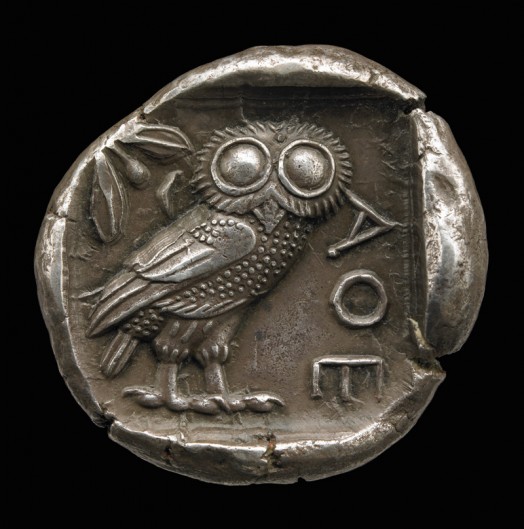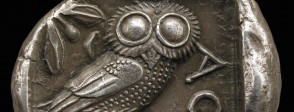
The coin and what it was worth
This silver coin was minted at Athens and carries a number of motifs symbolic of the city. On the obverse (principal) side is the head of Athena, patron goddess of Athens. She wears a necklace and earrings and a richly decorated helmet representing the warlike aspect of her character. The reverse of the coin shows an owl and a sprig of olive, the bird and tree associated with Athena, especially at Athens. On the right of the owl are the first three letters in Greek of the name of Athena and of Athens: AΘΗ.
The coin is a tetradrachm, meaning that it was worth four drachmas; one drachma, in turn, was worth six obols. It is a high value coin representing, in the mid-fifth century BC, four days’ pay for a skilled labourer or for a hoplite soldier, or two days’ pay for a sculptor working on a public building. It represents 12 days of welfare payment for a poor Athenian man unable to work or 24 days of pay for a citizen serving on a jury or for an unskilled labourer. This coin might have bought something like 54 litres of wheat (around 54 days’ rations for a soldier) or 12 litres of olive oil or 37 litres of local wine, but it is worth noting that estimates of prices for wheat and oil are unreliable. A cloak cost 20 drachmas, a plain black wine-mixing bowl 9 obols, and a small decorated oil flask 6 obols. A cow would cost somewhere between 25 and 51 drachmas and we have examples of the prices of slaves from an auction of a man’s property: a slave child from Caria (in present-day Turkey) cost 75 drachmas, a woman from Thrace (present-day north-eastern Greece, north-western Turkey and southern Bulgaria) cost 135 and a man from Syria cost 301.
Mining and silver
The silver for the tetradrachm came from the mines at Laureion, about 50km from Athens. These were owned by the state, but contracts for digging the silver were let to private individuals. The silver from Laureion was important in the financing of Athens’ navy and of other public projects. The mines were worked by large teams of slaves working in terrible conditions in narrow passages with the only light coming from burning oil lamps. Private individuals were able to make large amounts of money from hiring out slaves to work in the mines; one Athenian politician hired out as many as 1000 slaves.
The coins were made of pure metal so they were not just a currency with symbolic value, but also bullion and thus a means of exporting the metal itself. Silver was probably the single most important Athenian export. For a period, Athens imposed her coinage on the subject cities of her empire, but the high quality of the silver in the coins meant that they circulated much more widely and have been found throughout the Mediterranean region and beyond in the Middle East and even India. Their popularity and use in trade was probably a factor in the retention of the distinctive design of Athenian coins, which was a mark of their quality. While many other cities changed coin designs quite frequently, Athens kept the same one for 200 years.
Agriculture
In spite of the importance of silver, most Athenians, like most other Greeks, made their living by agriculture. The wealthiest Athenian landowners held large estates; at the other end of the scale was the small farmer whose land provided him with just enough to maintain his family and to allow him to fulfil his responsibilities as a citizen. A wide variety of crops were grown and some animals were kept, but the principal three crops were cereals (mainly barley with some wheat), grapes for wine and olives. Olive oil was essential to ancient Greek life as it was the main fat consumed and was also used for lighting and for personal hygiene. Athenian olive oil was famous for its quality and was given as a prize to winners in the Athenian games, the Panathenaia – its actual as well as its symbolic importance to the city is demonstrated by the sprig of olives on the tetradrachm.
Trade and manufacturing
The Athenian politician Perikles remarked that Athenians, unlike other Greeks, expected to be able to enjoy products from all over the world not just those they had produced themselves. The relative wealth of Athens meant that the conspicuous consumption of imported goods played a prominent role in social competition, involving a wide range of luxury goods such as ivory and glass from Egypt, dyes, spices and perfumes from the Middle East, textiles from Carthage and a variety of foodstuffs including dates, chestnuts and fine cheese and wines. However, in common with all other Greek cities, Athens needed to import a several basic commodities: grain and slaves from Egypt or the Black Sea area, wood, hides, and metals such as copper, tin, gold and iron.
In return, Athens exported silver and some manufactured goods, including fine painted pottery, though this probably played only a limited role in the Athenian economy as a whole. Craft industries such as pottery production, leatherworking and woodworking seem to have been based in small-scale workshops consisting of a master with a few slaves and in some cases may have operated from the home. Textile production was very much a home industry carried out by the women of the house. Many craft-workers were resident foreigners who, while they might be wealthy and cultured, could not own land and had no political rights. There was a very clear social hierarchy embedded in the economy of 5th century Athens: at the top were the landowners, whether rich or poor, and both traders and craft-workers were regarded as inferior to them; at the bottom came the slaves and with them those who, while free citizens, were slaves to their need to make a living by being employed by someone else.
More information
Introduction to Greek coinage with further pages
http://www.penn.museum/sites/greek_world/
PDF of booklet about the Athenian Agora (market place) and the activities that went on there
http://www.agathe.gr/Icons/pdfs/AgoraPicBk-12.pdf
Information about state and individual finances in Athens
http://www.tulane.edu/~august/H310/handouts/Finances.htm
Information and sources on work in ancient Greece
http://www.rwaag.org/gjobs
Outline summary of information on work and agriculture
http://www.ancientgreece.co.uk/staff/resources/background/bg19/home.html
Detailed essay on the ancient Greek economy
http://eh.net/encyclopedia/the-economy-of-ancient-greece/
Introduction to Greek trade and colonization
http://www.metmuseum.org/toah/hd/angk/hd_angk.htm
Source of reasonably priced, good quality replica coins including a tetradrachm
http://www.museumreproductions.co.uk/shop/viewitem.php?productid=149
Christopher Howgego, Ancient history from coins, Routledge, 1995
More information
-
Introduction to Greek coinage with further pages
Source: penn.museum
-
PDF of booklet about the Athenian Agora (market place) and the activities that went on there
Source: agathe.gr
-
Information about state and individual finances in Athens
Source: tulane.edu
-
Information and sources on work in ancient Greece
Source: rwaag.org
-
Outline summary of information on work and agriculture
Source: ancientgreece.co.uk
-
Detailed essay on the ancient Greek economy
Source: eh.net
-
Introduction to Greek trade and colonization
Source: metmuseum.org
-
Source of reasonably priced, good quality replica coins including a tetradrachm
Source: museumreproductions.co.uk
-
Christopher Howgego, Ancient history from coins, Routledge, 1995
Source:


